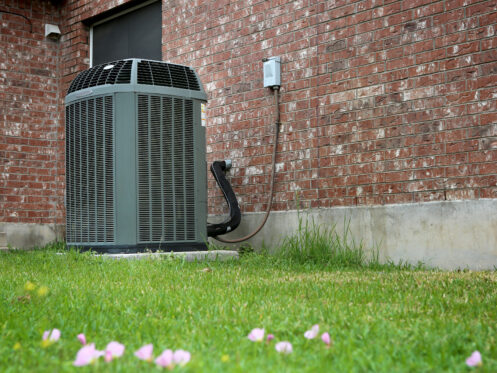Even if you’re not an air conditioning expert, you likely have at least some idea of what a refrigerant is. After all, there’s a hint right in the name. A refrigerant is the substance your air conditioner uses to cool your home. However, there’s quite a bit more to know about the role this substance plays inside your air conditioner. To elaborate, here’s everything you need to know about refrigerants. We’ll cover what they are, how they work, and what happens if your AC runs low.
What Is a Refrigerant?
Put simply, a refrigerant is a heat transfer medium. That means it’s a substance that can readily absorb heat and release it under controlled conditions. In practice, just about any liquid that you can boil can function as a cooling medium. You’ll find refrigerants in a variety of devices. They’re in air conditioners, heat pumps, refrigerators and freezers. Without this substance, none of those devices could function.
Common Refrigerant Types
Since air conditioning is so common these days, almost everyone has seen the names of today’s common refrigerants. You may have seen them in auto parts stores or heard of them during an AC maintenance visit. All refrigerants have a designation that begins with an R, followed by some combination of letters and numbers. A notable example is R-718. You may know it by its more common name, water. However, water isn’t commonly used as a refrigerant these days. The following are the refrigerants in most AC systems right now.
R-12
Even though modern air conditioners no longer use it, R-12 is probably the refrigerant you’re most likely to recognize. However, you likely know it by its trade name, Freon. R-12 was the most common air conditioning refrigerant up until around 1995. It’s very efficient as a heat transfer medium but has a fatal flaw. That flaw is that R-12 can destroy the ozone layer when released into the atmosphere. It breaks down when exposed to solar radiation and releases chlorine atoms. Those atoms bond to ozone and destroy it. Worse still, R-12 is also a powerful greenhouse gas, meaning it traps heat in the atmosphere, accelerating global warming. According to scientists, R-12 is 10,900 times more potent as a greenhouse gas than carbon dioxide.
R-410a
In 1995, governments around the world banded together to phase out the use of R-22. In its place, newer residential air conditioning systems began using a refrigerant called R-410a. It’s the most common coolant found in operating air conditioners today. R-410a has various advantages over its predecessor, including more efficient heat transfer. However, most importantly, it doesn’t harm the ozone layer if released. Plus, it’s less potent than a greenhouse gas and is only 2,088 times more potent than carbon dioxide.
R-454b
Extremely new AC systems are beginning to use a refrigerant called R-454b in place of R-410a. The primary reason for that is that R-454b is more energy efficient. Like its predecessor, R-454b poses no threat to the ozone layer. And best of all, R-454b is only 466 times more potent than carbon dioxide as a greenhouse gas.
Are AC Refrigerants Interchangeable?
Although different refrigerants perform the same function inside an AC system, they’re not interchangeable. One reason for this is that the different types all have different boiling points and containment requirements. That means an AC cannot operate with the wrong refrigerant. Plus, adding the wrong type can damage your AC. If you’re wondering what kind of chilling agent your current AC uses, there are a few ways to find out. If you have the original documentation for your AC, it should specify what the system requires. If you don’t have these documents handy, you can look at the outdoor unit. There, you should find a data plate that lists the type the system uses. Otherwise, you can call Blue Best Plumbing, Heating, Air, & Generators, and we’ll send an HVAC technician to check the refrigerant type for you.
How the Refrigeration Cycle Works
Your AC uses its refrigerant to capture heat inside your home, carry it outside and expel it into the outdoor environment. It does that by taking advantage of a few important scientific principles. One is the second law of thermodynamics. It states, in part, that heat energy spontaneously moves from hotter to colder substances. The other major principle involved is the relationship between pressure, temperature and boiling points in liquids. In short, when you increase the pressure of a liquid, two things happen. One is that its temperature increases. The other is that its boiling point increases. The opposite of both is also true. An air conditioner uses that principle to create something called a refrigeration cycle.
The refrigeration cycle begins in your AC in its outdoor unit. When your AC comes on, it passes its liquid refrigerant through an expansion valve. That reduces its pressure, temperature and boiling point. Upon leaving the valve, the liquid refrigerant is between 40- and 50-degrees Fahrenheit. From there, the cold thermal transfer fluid travels into the indoor unit of your AC.
Once inside, the cold refrigerant travels through a set of coils called evaporator coils. Those coils have metal fins wrapped around them to facilitate heat transfer. At that point, your AC blower turns on and circulates hot air from your home over the coil fins. Since the air is warmer than the refrigerant, it surrenders heat energy to this cooling medium. As that happens, the air grows cold, and the refrigerant gets hotter. Eventually, this causes this substance to boil into a vapor.
The now-warm vapor then travels back out to your AC’s outdoor unit. There, it passes through a compressor, which raises its pressure, temperature and boiling point. Upon leaving the compressor, the refrigerant vapor is between 120- and 140-degrees Fahrenheit. Then, the hot vapor goes through another set of coils called condenser coils. While there, a large fan blows outdoor air over the coils, forcing the refrigerant to surrender its heat energy. This allows the refrigerant to condense back into a liquid to begin its journey again.
What Happens When Your AC Runs Low on Refrigerant?
Running your AC while it’s low on refrigerant can destroy its compressor. However, before that happens, you’ll likely notice a few other symptoms first. Oddly enough, one of those signs might be frost on your refrigerant lines. Your AC evaporator coils may also freeze. This happens because of the very same relationship between pressure and temperature we previously discussed. With too little refrigerant in your AC, what is remaining will get far colder than it’s supposed to. The substance simply has more room to expand, which drops its pressure and temperature more than is needed.
Unfortunately, operating with low refrigerant also affects the boiling point of what is remaining. When the system gets far enough away from its proper refrigerant charge, it can destroy the compressor. That happens because the refrigerant stops boiling when it’s supposed to. When that happens, the remaining refrigerant may enter the compressor in a liquid state. Since the compressor’s not built for that, it will fail.
Your Trusted HVAC Team
If your AC needs a refrigerant recharge, or if you want an AC with a newer refrigerant, Blue Best Plumbing, Heating, Air, & Generators can help. We offer comprehensive HVAC services, including installation, maintenance, and repair throughout Bountiful, UT. We also offer complete plumbing, commercial HVAC and indoor air quality services. Our team of HVAC technicians is NATE-certified, so they’re the best in the business. And we’re Better Business Bureau-accredited with an A+ rating. So, if you need heating or air conditioning services in Bountiful, call our experts at Blue Best Plumbing, Heating, Air, & Generators today!








